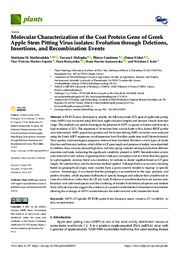Molecular characterization of the coat protein gene of greek apple stem pitting virus isolates: evolution through deletions, insertions, and recombination events.
Molecular characterization of the coat protein gene of greek apple stem pitting virus isolates: evolution through deletions, insertions, and recombination events.
Author(s): MATHIOUDAKIS, M. M.; MALIOGKA, V. I.; CANDRESSE, T.; NICKEL, O.; FAJARDO, T. V. M.; BUDZYNSKA, D.; JAROSZEWSKA, B. H.; KATIS, N. I.
Summary: A RT-PCR assay developed to amplify the full coat protein (CP) gene of apple stem pitting virus (ASPV) was evaluated using 180 Greek apple and pear samples and showed a broad detection range. This method was used to investigate the presence of ASPV in quince in Greece and showed a high incidence of 52%. The sequences of 14 isolates from various hosts with a distinct RFLP profile were determined. ASPV population genetics and the factors driving ASPV evolution were analyzed using the Greek ASPV sequences, novel sequences from Brazilian apple trees and Chinese botanical Pyrus species, and homologous sequences retrieved from GenBank. Fourteen variant types of Greek, Brazilian and botanical isolates, which differ in CP gene length and presence of indels, were identified. In addition, these analyses showed high intra- and inter-group variation among isolates from different countries and hosts, indicating the significant variability present in ASPV. Recombination events were detected in four isolates originating from Greek pear and quince and two from Brazilian apples. In a phylogenetic analysis, there was a tendency for isolates to cluster together based on CP gene length, the isolation host, and the detection method applied. Although there was no strict clustering based on geographical origin, most isolates from a given country tended to regroup in specific clusters. Interestingly, it was found that the phylogeny was correlated to the type, position, and pattern of indels, which represent hallmarks of specific lineages and indicate their possible role in virus diversification, rather than the CP size itself. Evidence of recombination between isolates from botanical and cultivated species and the clustering of isolates from botanical species and isolates from cultivated species suggest the existence of a possible undetermined transmission mechanism allowing the exchange of ASPV isolates between the cultivated and wild/ornamental hosts.
Publication year: 2021
Types of publication: Journal article
Unit: Embrapa Grape & Wine
Keywords: ASPV
Observation
Some of Embrapa's publications are published as ePub files. To read them, use or download one of the following free software options to your computer or mobile device. Android: Google Play Books; IOS: iBooks; Windows and Linux: Calibre.
Access other publications
Access the Agricultural Research Database (BDPA) to consult Embrapa's full library collection and records.
Visit Embrapa Bookstore to purchase books and other publications sold by Embrapa.

